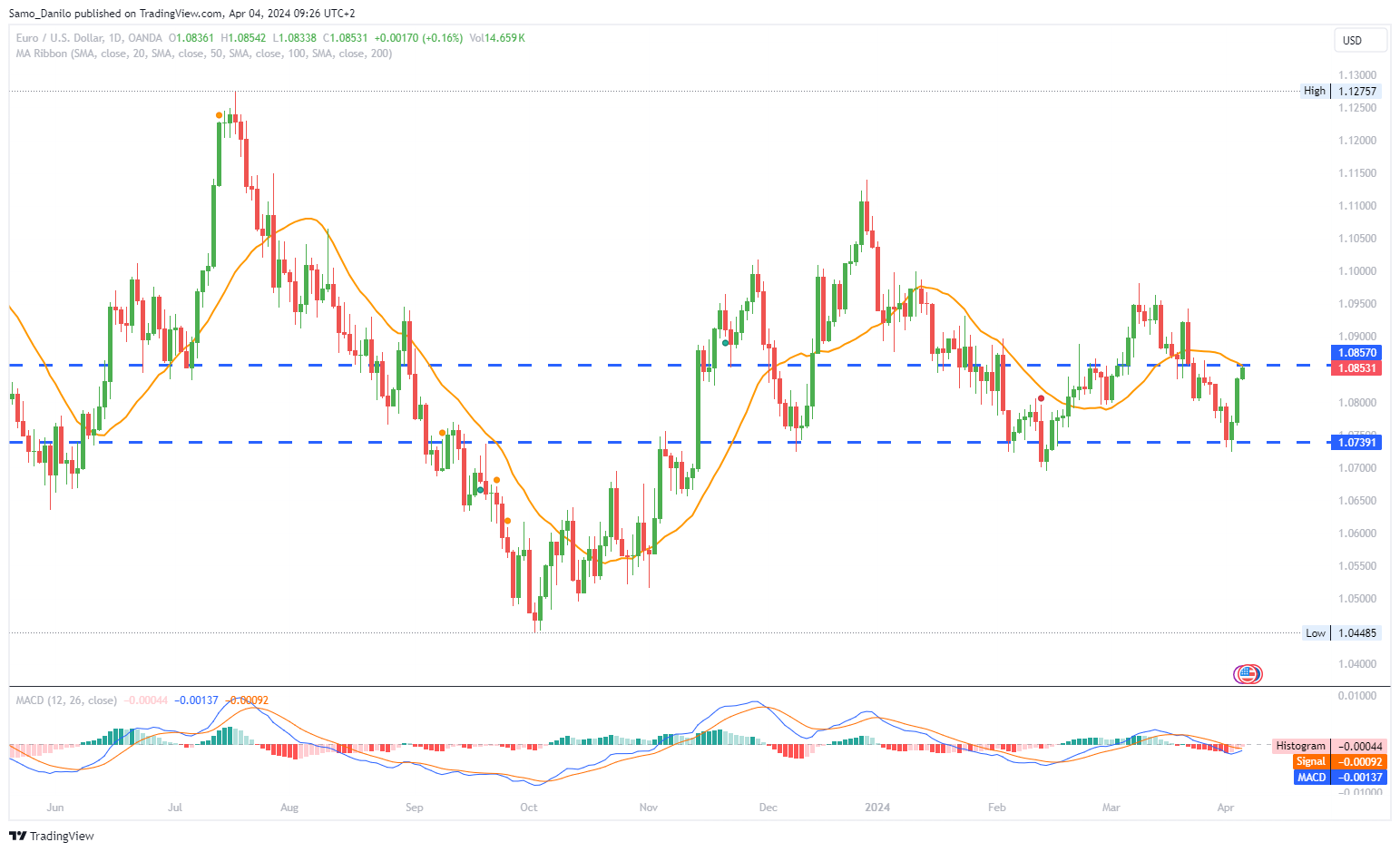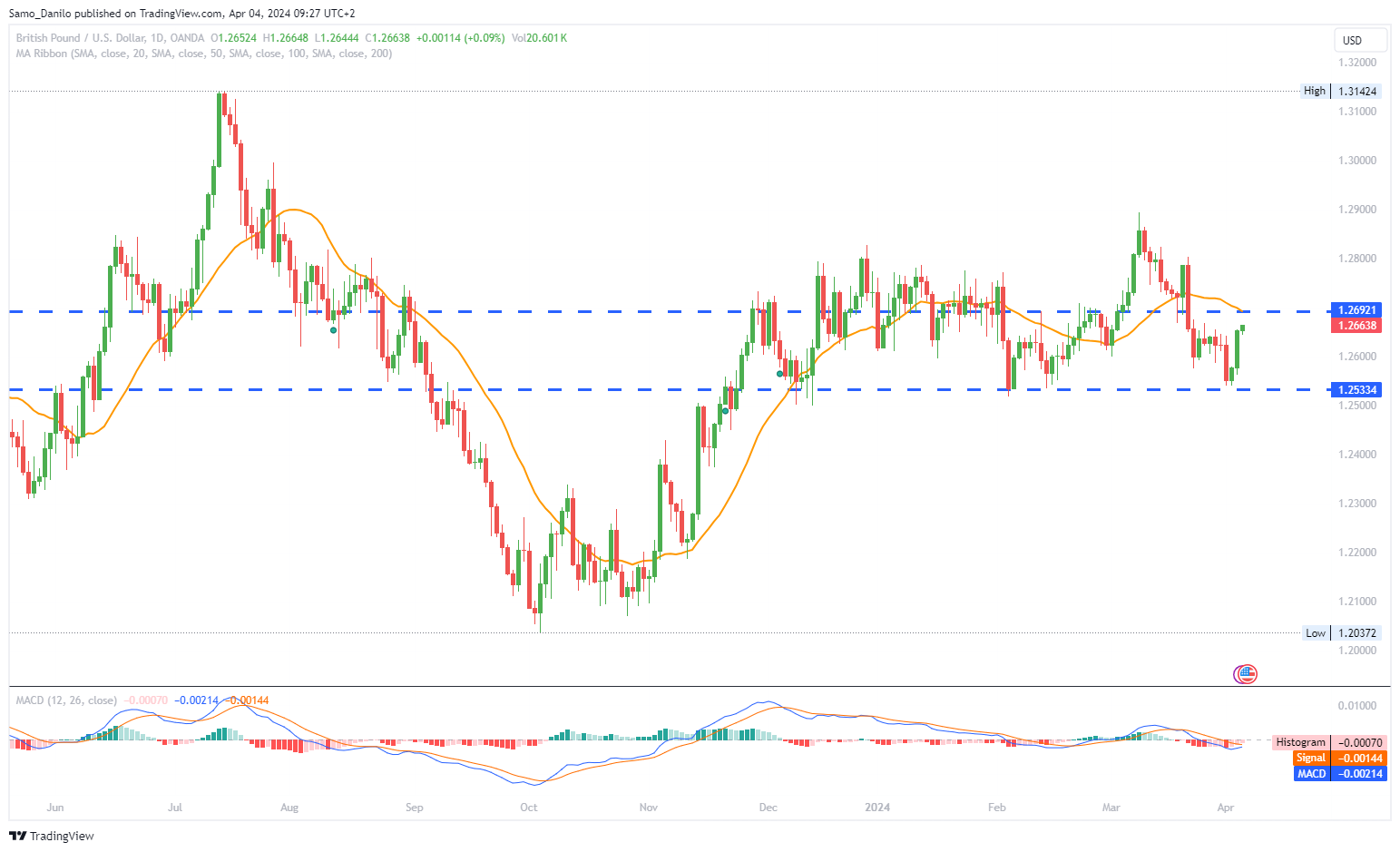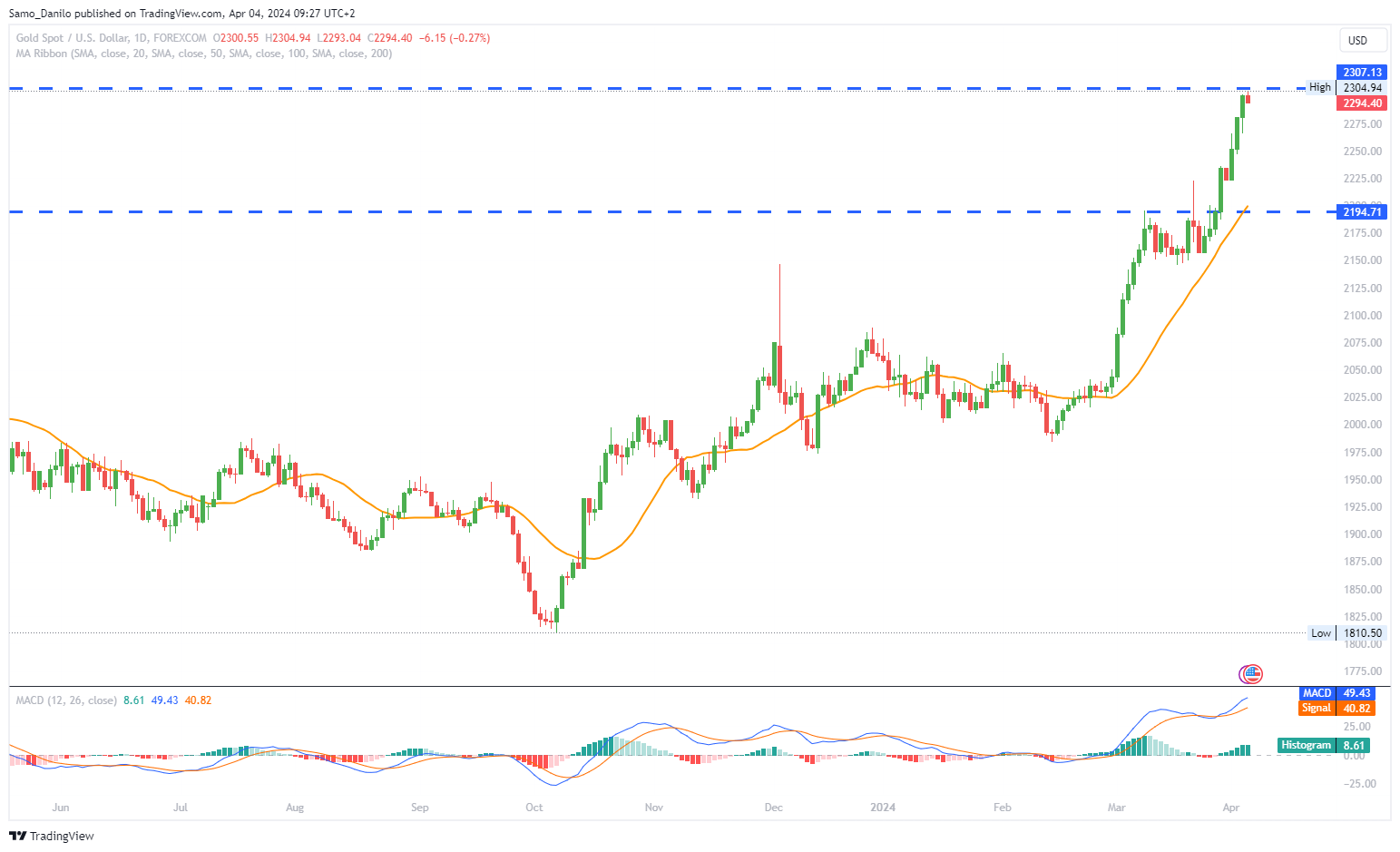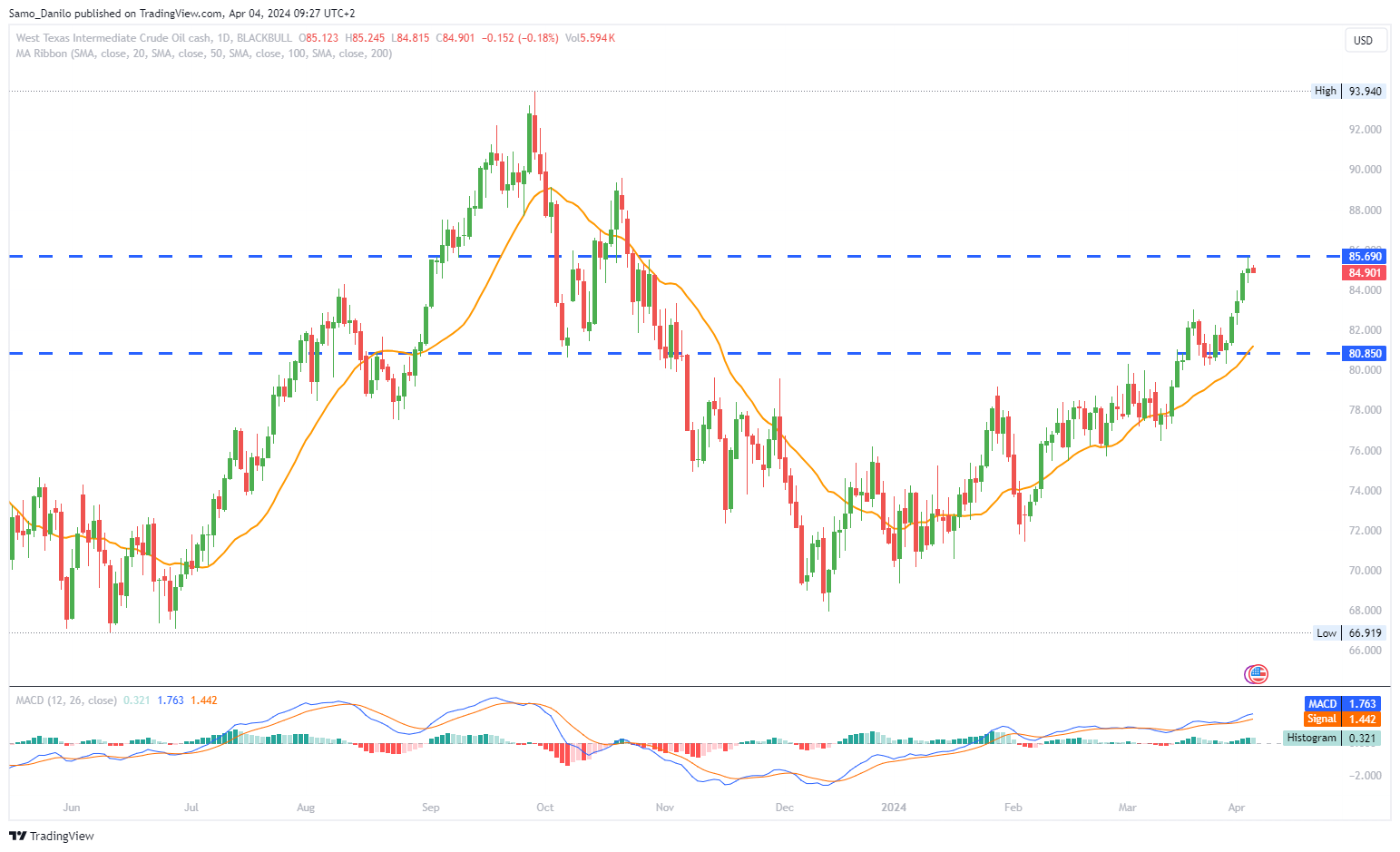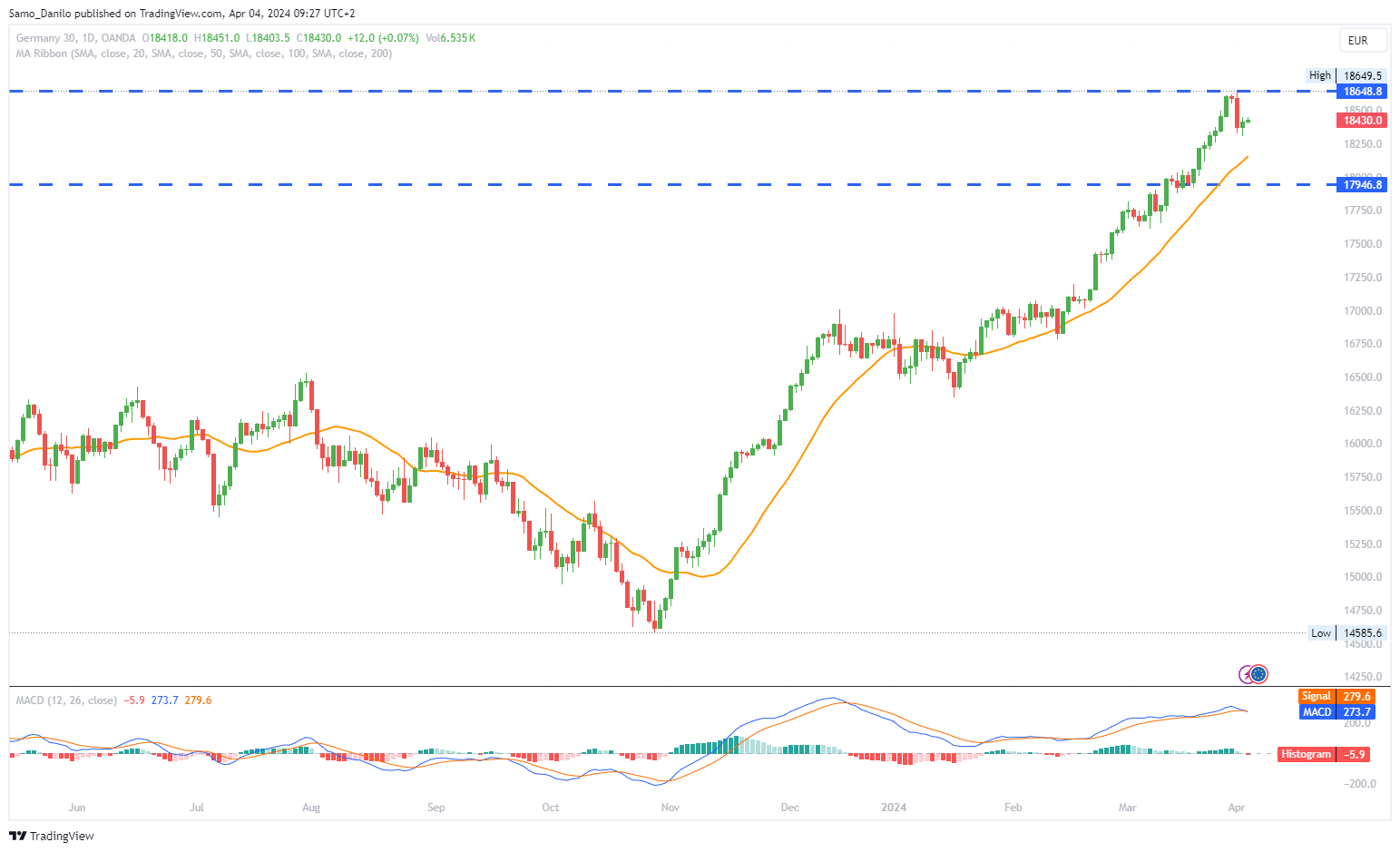EURUSD
- The EUR/USD edges higher, approaching 1.0850 during Thursday's European session, indicating a slight strengthening of the Euro against the US Dollar.
- The US ISM Services PMI declines to 51.4 in March from 52.6 in February, signaling a slowdown in the services sector and potentially impacting the US Dollar's performance.
- ADP data shows a rise in private sector employment in the US, with an increase of 184K jobs in March, surpassing market expectations and potentially bolstering the US Dollar.
- The Eurozone inflation rate for March dropped more than anticipated, raising speculation about a potential ECB interest rate cut in June, which could influence the Euro's value against the Dollar.
- Market participants await the release of final HCOB Services PMIs for Germany and the Eurozone, as well as US February Balance of Trade and weekly Initial Jobless Claims data, for further insights into economic conditions that could impact EUR/USD trading dynamics.
Closing statement: EUR/USD sees modest gains amid a mix of economic data releases. While weaker-than-expected US services PMI figures and strong ADP employment data create divergence, the Euro faces pressure from lower-than-anticipated Eurozone inflation, sparking speculation about potential ECB rate cuts. Investors await additional data releases from both regions to gauge the currency pair's future direction.
GBPUSD
- GBP/USD trades above 1.2650 early Thursday, benefiting from a weaker US Dollar, which supports the Pound against its American counterpart.
- ADP Employment Change data for the US reveals a robust increase of 184,000 jobs in March, surpassing both February's figure and market expectations, potentially boosting the US Dollar.
- However, the US ISM Services PMI declines to 51.4 in March from 52.6 in February, falling short of expectations, which could exert downward pressure on the US Dollar.
- Adriana Kugler, a member of the Fed Board of Governors, highlights the ongoing disinflationary trend, hinting at the possibility of future rate cuts, which may influence investor sentiment towards the US Dollar.
- Traders in the money market futures anticipate a 25-basis point rate cut by the Bank of England (BoE) in June, with the probability currently standing at 66%, potentially impacting the Pound's performance against the US Dollar.
| SMA (20) | Slightly Falling |
| |
| RSI (14) | Slightly Rising |
| |
| MACD (12, 26, 9) | Falling |
|
|
Closing statement: GBP/USD sees mixed trading dynamics as it hovers above 1.2650 amidst divergent economic data releases. While robust US employment figures support the Dollar, weaker-than-expected ISM Services PMI data exerts pressure. Additionally, comments from a Fed official on disinflationary trends and market expectations for a BoE rate cut in June further influence sentiment towards the currency pair.
GOLD
- Gold price flirts with the $2,300 level, nearing its all-time high of $2,305 reached earlier on Thursday, reflecting ongoing bullish sentiment in the market.
- The US Dollar weakens further after Fed Chair Jerome Powell's remarks on potential interest rate cuts this year, reinforcing support for gold as an alternative asset.
- Fed Governor Adriana Kugler anticipates that the disinflation trend will persist, potentially paving the way for interest rate cuts, which could further boost gold prices.
- However, caution prevails as the technical analysis indicates that gold is highly overbought, raising concerns about the sustainability of its upward movement.
- Geopolitical tensions in the Middle East could serve as a catalyst for another surge in gold prices if they resurface, adding to the metal's appeal as a safe-haven asset.
| SMA (20) | Rising |
|
|
| RSI (14) | Rising |
|
|
| MACD (12, 26, 9) | Rising |
|
|
Closing statement: XAU/USD continues its bullish momentum as gold flirts with the $2,300 level, buoyed by a weakening US Dollar and expectations of potential interest rate cuts by the Federal Reserve. However, caution is advised as technical indicators suggest gold is overbought, while geopolitical tensions in the Middle East remain a key factor influencing price movements.
CRUDE OIL
- West Texas Intermediate (WTI) crude oil prices are in a bullish consolidation phase, trading near their highest level since October 2023, as the Asian session unfolds on Thursday.
- Despite an unexpected build in US crude stockpiles reported by the Energy Information Administration (EIA) on Wednesday, oil prices remain supported by concerns over supply disruptions in the Middle East and tight global supply.
- The downside for crude oil prices is tempered by signs of improving demand and a meeting of top OPEC+ ministers, which maintained unchanged oil supply policies and urged increased compliance with output cuts.
- Moreover, upbeat Chinese manufacturing data earlier in the week has bolstered optimism about rising oil demand from the world's largest crude importer, further supporting oil prices.
- Overall, crude oil prices continue to exhibit strength amid a combination of supply concerns, improving demand outlook, and OPEC+ efforts to stabilize the market.
| SMA (20) | Rising |
|
|
| RSI (14) | Rising |
|
|
| MACD (12, 26, 9) | Rising |
|
|
Closing statement: WTI crude oil prices maintain a bullish stance, hovering near multi-year highs despite an unexpected build in US crude stockpiles. Supply disruption concerns in the Middle East, coupled with signs of improving demand and OPEC+ efforts to support prices, underpin the bullish sentiment in the crude oil market. Additionally, upbeat Chinese manufacturing data reinforces optimism about future oil demand, contributing to the overall strength in crude oil prices.
DAX
- Eurozone inflation figures prompted speculation about a potential ECB interest rate cut in June, as the annual core inflation rate eased to 2.9% and the overall inflation rate declined to 2.4% in March.
- Softening inflation indicators, coupled with stagnant Eurozone unemployment rates, underscored the necessity for supportive monetary policies.
- Fed Chair Powell's affirmations regarding future rate cuts reinforced market expectations, despite recent inflation data having little impact on the Fed's stance.
- Investors are closely monitoring German and Eurozone Services PMI releases, as the services sector plays a significant role in shaping inflation trends.
- Against a backdrop of growing ECB support for a June rate cut, market participants are awaiting insights from the ECB Monetary Policy Meeting Minutes, expected later in the session.
| SMA (20) | Rising |
|
|
| RSI (14) | Slightly Rising |
| |
| MACD (12, 26, 9) | Rising |
|
|
Closing statement: Eurozone inflation figures have intensified speculation about a potential ECB interest rate cut in June, as both core and overall inflation rates softened in March. The stagnant Eurozone unemployment rate further emphasizes the need for supportive monetary policies. Fed Chair Powell's assurances regarding future rate cuts have bolstered market expectations, despite muted reactions to recent inflation data. With investors closely eyeing services PMI releases and awaiting insights from the ECB's Monetary Policy Meeting Minutes, market sentiment remains influenced by expectations of forthcoming policy adjustments.
